I’m almost as obsessed with compost as I am with food. Well, they are related, right? Living out here has taught our family how to conserve resources – like many non-city folk, we have our own well (and no, we don’t have to churn buckets down a deep hole – it’s a little more sophisticated than that), a massive underground propane tank to fuel our outdoor cooking grill, water pumped from our 2 ponds to water the garden and lawn.
This winter and spring has been very dry for us – our ponds, stocked with TONS of fish, turtles and a baby alligator is down by 3/4 (poor fishies!) so we’ve stopped watering our lawn and property for the time being (which is why everything’s a little brown and weedy right now).
 We used to have 2 compost systems – one a worm compost and the other a more traditional compost bin about the size of a refrigerator. It wasn’t quite efficient enough for us (we go through a lot of food in our recipe testing) so I thought – hey, why not COMBINE the two systems? How about throwin’ in all those hungry worms into the giant compost bin and they can eat ‘n poop to their heart’s content. (fyi for compost newbies – the worm poop…errr….”castings”….is one of the riches and nearly free fertilizers for your garden).
We used to have 2 compost systems – one a worm compost and the other a more traditional compost bin about the size of a refrigerator. It wasn’t quite efficient enough for us (we go through a lot of food in our recipe testing) so I thought – hey, why not COMBINE the two systems? How about throwin’ in all those hungry worms into the giant compost bin and they can eat ‘n poop to their heart’s content. (fyi for compost newbies – the worm poop…errr….”castings”….is one of the riches and nearly free fertilizers for your garden).
So I dumped approximately 3,156 worms (my kids tried to count them but we lost track after 56, so this is just a guesstimate) into the bin. A couple of days later, I looked in and the worms were fat ‘n happy, squriming in, under and around all the kitchen scraps. Every day after that, though, i noticed fewer and fewer worms. A week later, some new creatures emerged.
WHAT DID YOU DO TO MY WORMS?!??
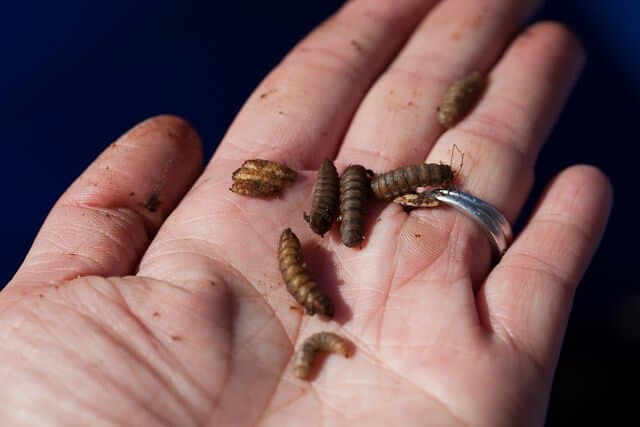
After some research, it turns out these guys are Hermetia Illucens – or Black Soldier Fly Larvae. Hermetia sounds much better. Black soldier flies look like regular flies, but are as big as a wasp and sound like bees.
But unlike regular annoying houseflies, BSF are good guys! They’re not considered pests – they aren’t naturally attracted to humans or food (they’re attracted to decaying matter.) They don’t bite or sting. They don’t buzz around you and pretty much stay clear of the people. The larvae are awesome at processing food scraps for compost.
Another benefit? The hens are MAD for them. Like jump into the compost bin crazy mad.
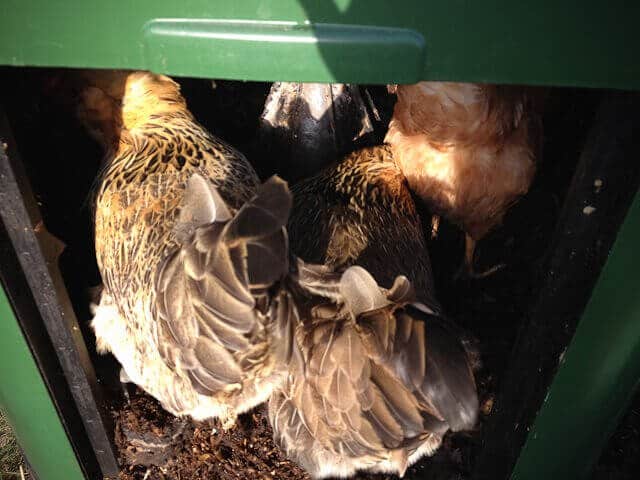
Free, delicious and nutritious chicken food…YAY! (well, delicious for the hens. I haven’t personally tried the Black Soldier Fly Larvae myself)

It turns out that the insulated compost bin (we have an Aerobin) is too hot of an environment for the redworms. Plus, the Black Soldier Fly Larvae are so efficient that they tend to eat up all the food, knocking the redworms out.
After a few months of experimenting, I think I have created our little “perfect storm” to make compost in as little as 3 days.
How to make compost in 3 days
Normally, it takes several weeks or months to turn food scraps and yard waste into compost….here’s how we make it in 3 days.
Green + Brown + Black Soldier Fly Larvae => Food for hens + compost for garden
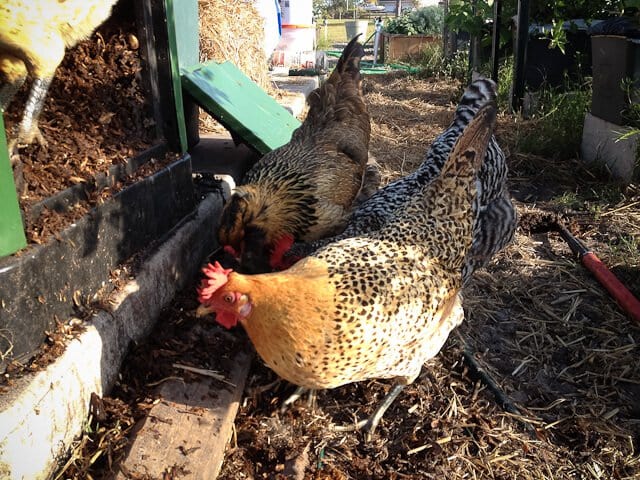
To make compost, you need GREEN + BROWN
GREEN: From the kitchen: veg & fruit scraps, leftovers, eggshells – I even include dairy and meat because it turns into compost before it can really spoil and smell). Green grass clippings.
BROWN: From the coop: Hen poop + pine shavings. We use small pine shavings for hen coop and sprinkle in Diatomacieous Earth (all natural fossilized diatoms of hard shelled algae) on top of the pine shavings. This helps break down, dry up the chicken poop and acts as an all-natural insecticide.
The coop with 6″ of pine shavings – the diatomacieous earth keeps it clean, so we only have to clean this out twice a year. As we take out the pine shavings for the compost, we’ll add a few handfuls of new pine shavings to the coop each time.
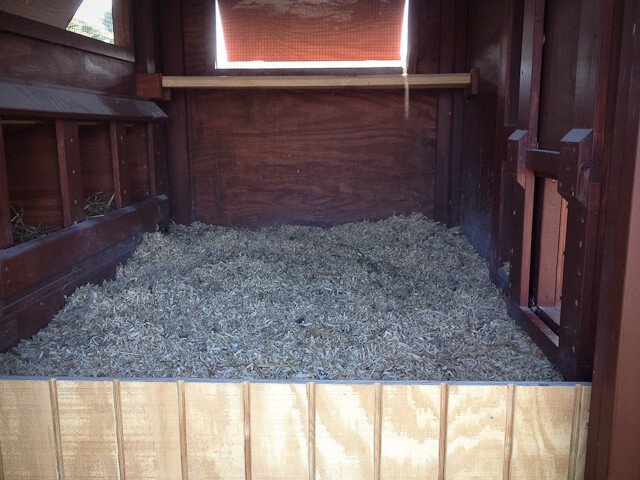
Now I know most of you probably don’t have chickens, but you can still buy pine shavings or straw from a local feed store or farm supply (that is, if you can’t gather enough dried leaves and brown matter from your own yard).
Pine shavings – this package will last you a long time:

Straw, not hay. Hay is dried grasses, which include seed and healthy stuff for animals. Straw is just dried plant stalk with no nutritional benefit. Just remember “hay is for horses. Hay is not as good for compost – all those grass seeds will end up in your garden.
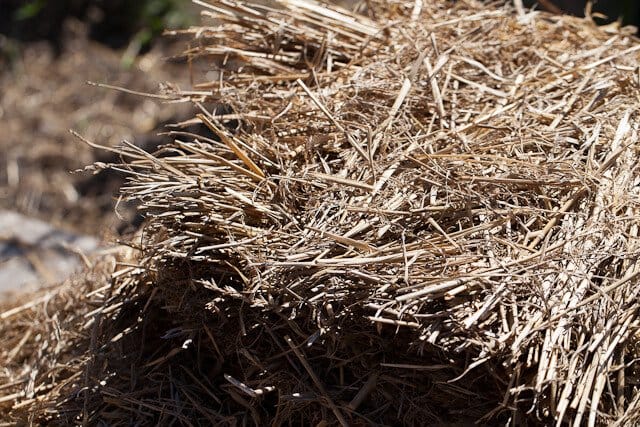
And of course, the Black Soldier Fly Larvae – thousands of them. Where do get ’em? Well, you can create an environment that would attract them.
So what does the compost look like?
Day 1: kitchen scraps on top of some pine shavings.
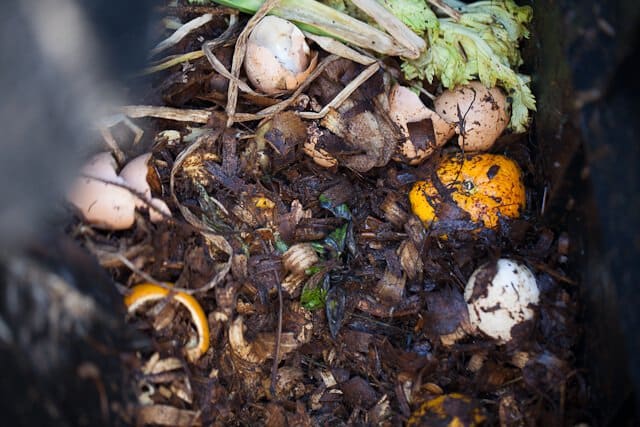
Three days later – most of the food is gone.
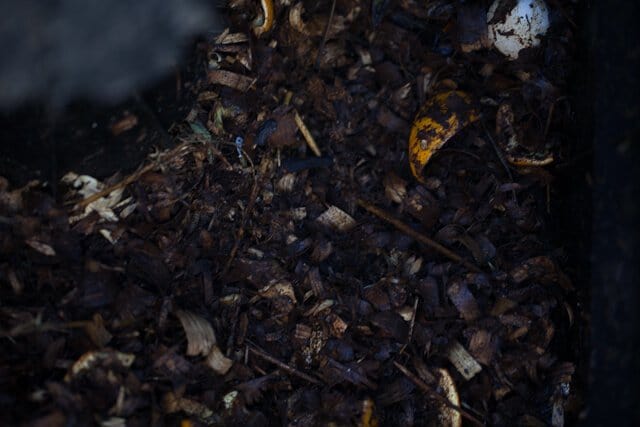
Every day, I take a couple shovelfuls out – here you can see the thousands of BSFL – so many you can’t count.
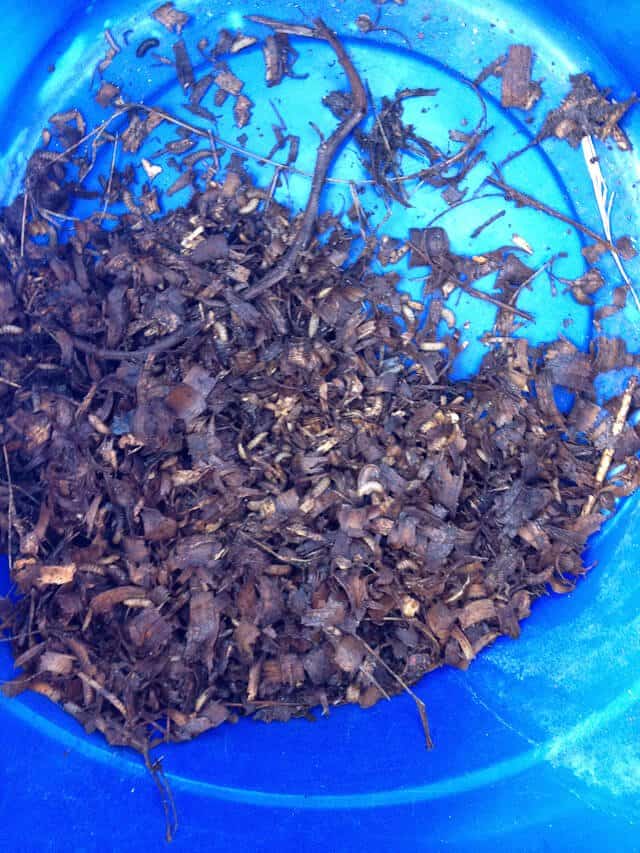
Dinner time!
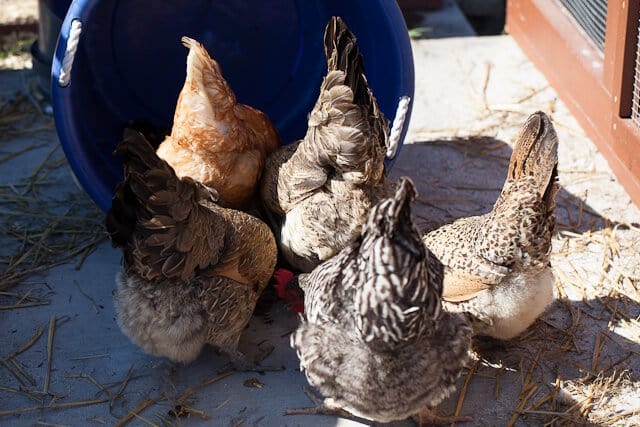
The rest of it – compost – goes in my garden bed mixed with soil.
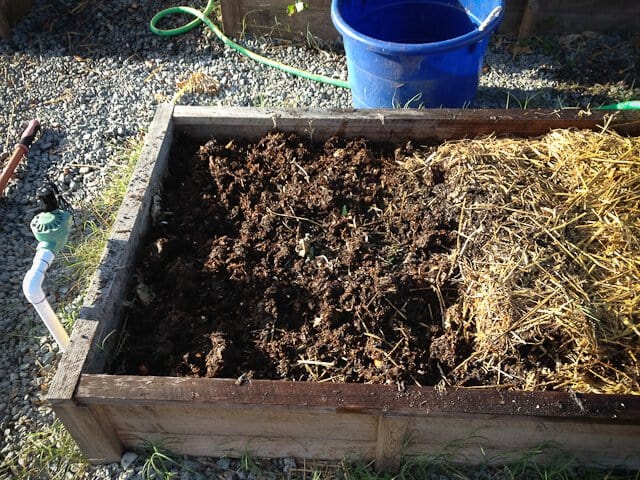
Then topped with 4″ of straw:
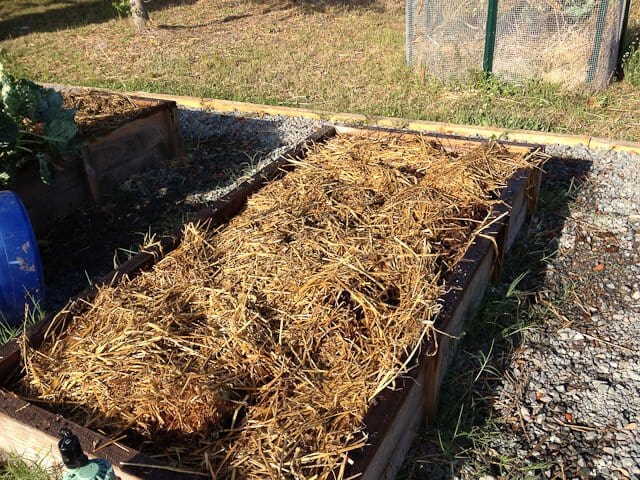
Which insulates the soil, prevents weeds and slows evaporation of water. I’ll just scootch a hay over, dig a little hole with my hands and plant.
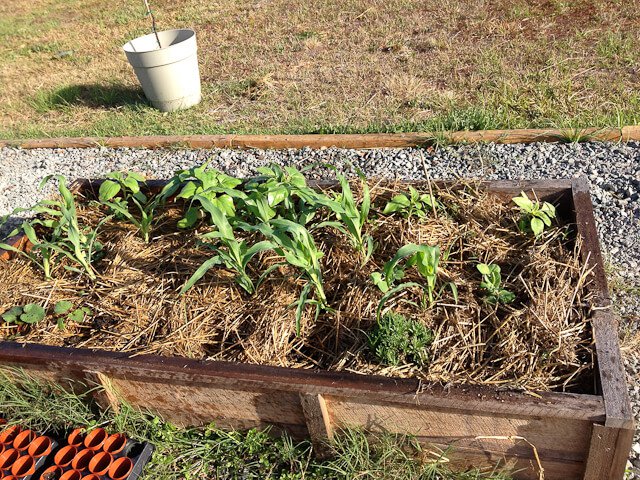
The garden grows good!
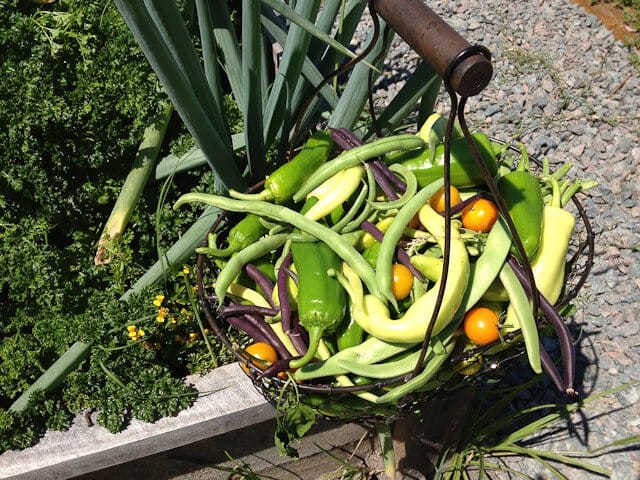
This is Nathan’s girlfriend, Julia. She’s my helper in the garden.

And this is my office sometimes. It’s too nice to stay indoors – so I drag my chair outside, a TV tray, laptop and coffee. Coco, the hens and the baby chicks (oh! I’ll have to post an update on how big they’re getting!) keep me company.
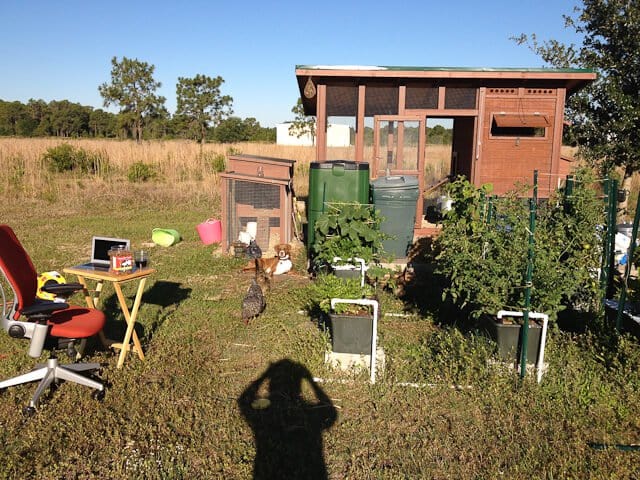
The honeybadger hens aren’t scared of the big dog!
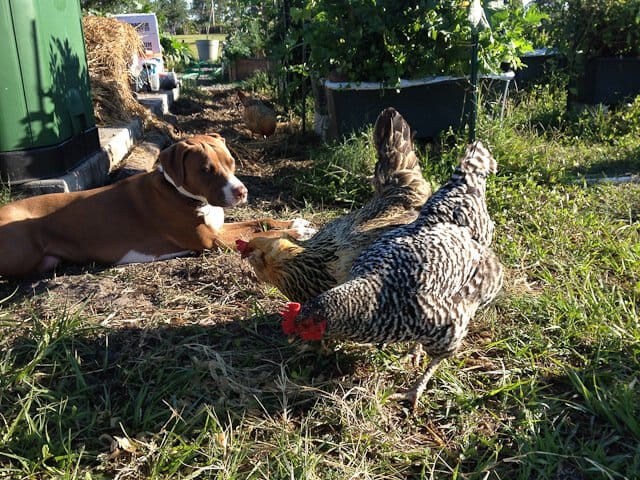
They like to eat from my hand.
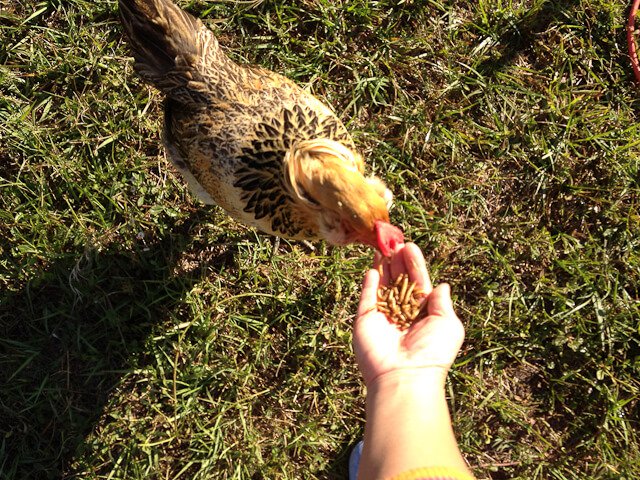
Especially fatty Olivia Superstar, who’s always hungry.

Other resources if you’re interested!
Living the Frugal LIfe – Black Soldier Fly Larvae
The Walden Effect – Black Soldier Fly Larvae for Compost and Chicken Feed
Avian Aqua Miser – Black Soldier Fly Larvae as Chicken Feed
The Modern Homestead – Black Soldier Fly, White Magic
Microponics – Black Soldier Fly Larvae



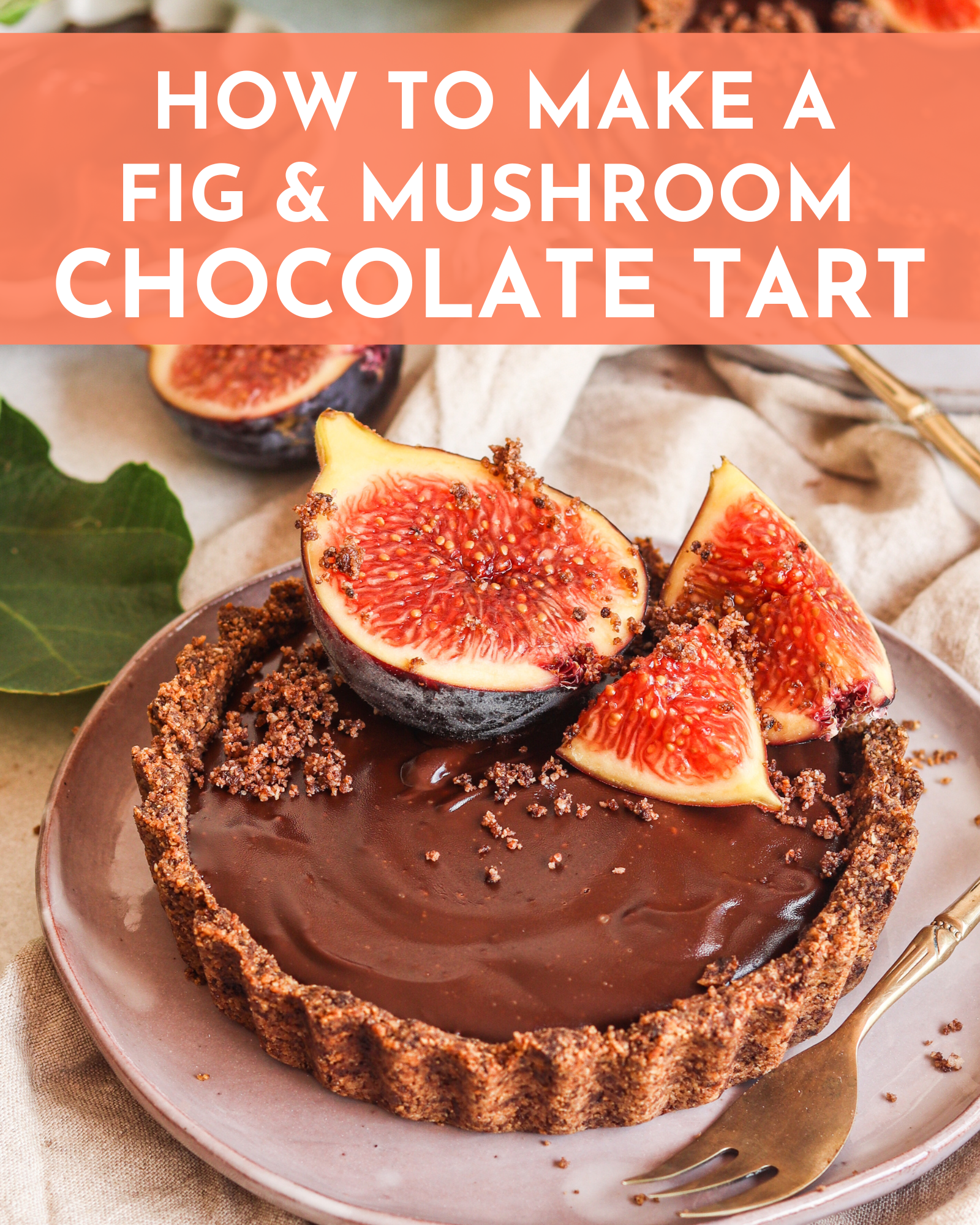
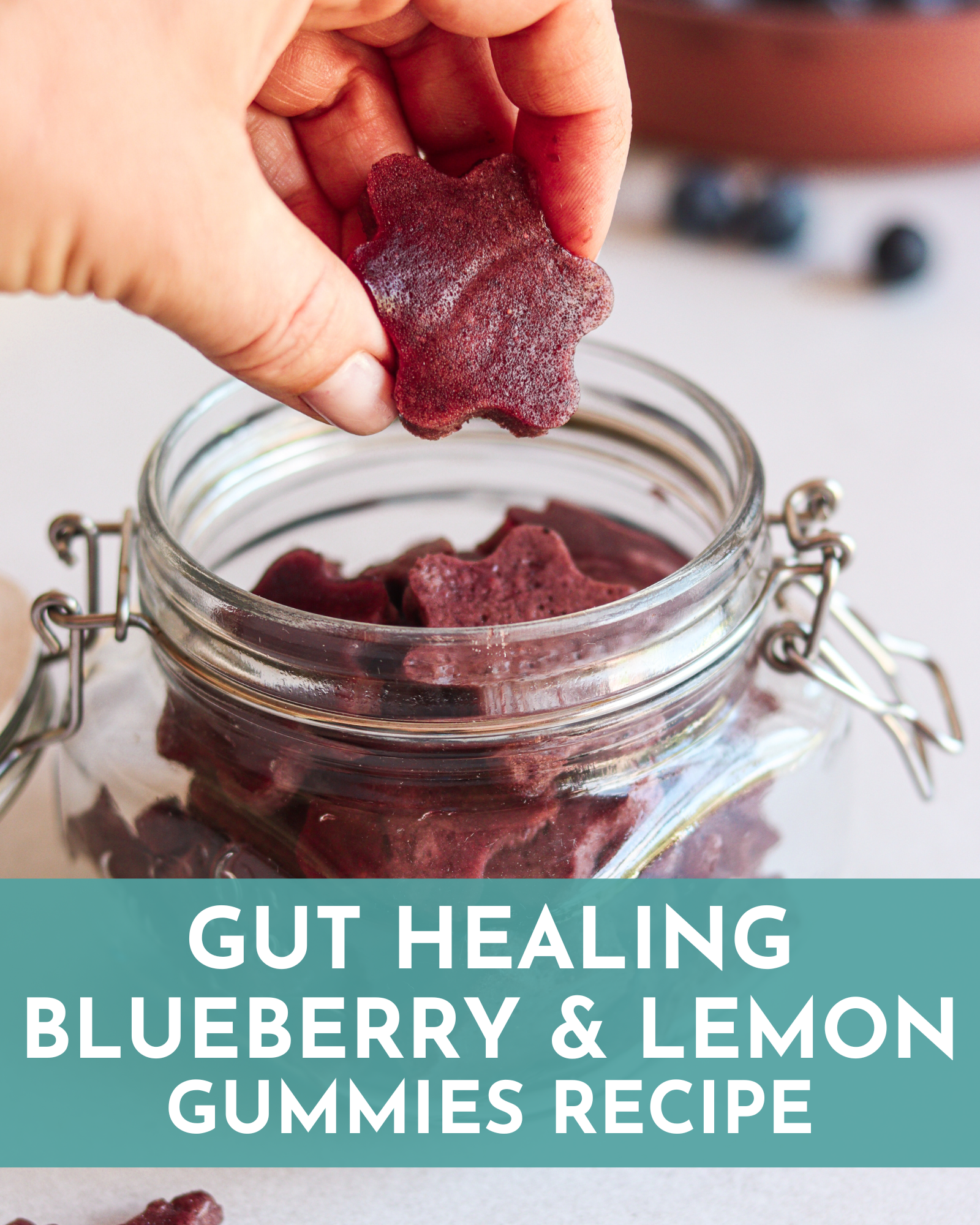
Hi there, I don’t have chickens and not a ton of food waste but I love my Soldier Fly compost. I use it to get rid of my dog poop from 2 Labradors. Do I need to turn the bins and add carbon or just let them eat and enjoy? How do I keep the population under control because as of now I have way too many and can’t meet their food demand.
Hello,
Great article, and I loved your pictures! I’ve been getting Black Soldier Fly Larvae in my compost for several years. I am in complete wonder at how quickly they break down food scraps! In less than a week, I will not see anymore food, and the compost is really dark, black/brown.
I do have a couple questions, though. Normally, when I get around to using my compost, the larvae are gone. So, am I correct that you pull the compost out your bin, let the chickens eat all the larvae, then spread it on your garden, larvae free? Next, are there any larvae left in the compost you put in your garden, and do you think the larvae would harm the plants or roots if you were to plant using compost with the larvae still in it?
I don’t know why it never occurred to me let my chickens eat the larvae, but I will, now. Thanks!
Thanks a bunch!
Natalie
How do the larvae get inside the bin if it’s enclosed (except from the bottom) like in your picture?
Great lesson
Thanks for the article. This is my first time composting and seeing all those larvae was scary.
Thanks for the useful information! I had no idea I can make compost so fast. It’s quite simple and effective way and I’m trying it definitely. Thannks for sharing!
I accidentally ended up with a BSF infestation, too. I put rotting birdseed in my red wiggler bin. The ammonia smell attracted flies (unbeknownst to me) & I had larvae within a couple of days. At first I was mortified, but after researching what they were, I was so excited. I have been using this composting mood for a while now, & the red wigglers are gone, We have very little waste as a family, due to recycling & composting. I have even gotten a few of my neighbors excited about it. They all brought their rotten Halloween pumpkins to my bin. It is amazing how quickly these creatures devour everything. I wish composting with BSF was more of a common practice. The world would be a much better place for it.
This is really helpful! I just checked my compost bin and found it’s of larvae, did a search, and found your post. We don’t have chickens but there are plenty of birds around and I’m hoping they’ll feast on the larvae if I spread the compost into our raised beds. We have cedar leaves/needles that I’ll spread on top instead of straw since it’s free 🙂
Don’t do it, BSFs don’t like any kind of evergreen needles, carbonaceous material or other stiff, stickery leaves. Just give them your kitchen rubbish and they will thrive.
lovely jubbly fantastic thanks so much
I am also a bit of a composting nut mixing cut grass with uncooked kitchen waste (are you sure cooked waste can be added, my main concern is it may attract vermin).
I also collect fallen leaves at the season end and this turns into rich leaf mold something you cannot buy here, the downside is that it can take up to three years to fully break down.
One question, do you add citrus peel and alliums (Garlic/onions) to your compost heap, I once read that these should not be included, what do you think.
Regards
Russ
My ‘bugs’ love a lot of the things you’re not supposed to put much of in a traditional compost pile. Onions, garlic, lots of grapefruit peels, they love it. Our bin smells like grapefruit peels right now, certainly a lovely way for so-called ‘garbage’ to smell 😉 I add the bones from our 24-hour stock, they are soft enough to crush with your fingers and they’re gone in a couple of days. I add small amounts of grease when we have any with no problems, too.
That’s so great to hear about to citrus peals! The Biopod manual warns against using them but… still no problems for you huh?
Hi Jacob – we make sure we don’t put in a ton of citrus peels, but the worms really do take care of breaking it down.
My mom found this article and passed it along to me. You have answered so many of my questions! I had the same experience with my compost last year, all of the redworms that I had added disappeared only to be replaced by these larvae. I had no idea if they were good or bad, but I did know that our new chickens loved them! I am still in the beginning stages of keeping chickens, composting, and growing some of our own food. I look forward to reading more of your blog. Thanks!
Ok, I stumbled on this post because I just found soldier fly larvae in my compost bin (which I started for the first time 2 months ago). Your post has been so helpful. I’ve been wanting chickens – now I have even more reasons to get some! But, when you transfer the compost to your garden, do you have to extract the larvae somehow? Or do you just leave them alone because they’l1l eventually turn into flies and go away?
I love your chickens, one of them reminded me of one of my own hens, named Marmelade, who is a prolific egg layer and who occasionally sits in my lap when I call her. Congrats on the tons of incredible useful information you have here.
Jaden, I have another question for you if you don’t mind.. The hen in the last picture of this post.. What kind is it? We got 12 chicks on April 10th, six different ‘breeds’ and we’ve been getting 3-6 eggs per day, but I can’t tell which hen is laying. Someone told me a while ago that when their ‘wobbles’ (?) get really red, they’re laying. Anyway, the two hens that look like the last picture of this post barely have a comb or waddle, but yesterday I got a blue/green egg. I’m wondering if it was from one of them. (Sorry.. one more comment.. one of the girls of this particular breed has cheeks. It looks like the downny fluff from baby-chick never grew out!.. Her name is Cheeks. And she sure is a silly looking hen!)
I love your chickens, one of them reminded me of one of my own hens, named Marmelade, who is a prolific egg layer and who occasionally sits in my lap when I call her. Congrats on the tons of incredible useful information you have here.
I love chickens! I wish I could have them in my back yard..
Ok, I stumbled on this post because I just found soldier fly larvae in my compost bin (which I started for the first time 2 months ago). Your post has been so helpful. I’ve been wanting chickens – now I have even more reasons to get some! But, when you transfer the compost to your garden, do you have to extract the larvae somehow? Or do you just leave them alone because they’ll eventually turn into flies and go away?
I will probably never accomplish such things as raising chickens but it is such a good thing to do. I have thought about having a worm composting bin. And maybe a little urban composting in the yard just to halt the methane in the landfills. 🙂 Love the chickens going after the larvae/grubs in the bin. lol
How fascinating!
We live in the Southeast and unwittingly attracted the BSF larvae to our new compost cone. Really, it’s a solar food digester that is partially buried and processes all types of food stuff. The instructions say to never put yard matter in it, only food. However, as much as I appreciate the BSF, I’m not sure how to get them to go away when I’m ready to harvest the compost. We don’t have chickens, so do I just stop feeding the compost and wait for them all to die? Should I install another compost so they can rotate every six months between the two? They compost things so quickly, but I have never composted before, so I don’t know how to get them to go away for harvesting. I bought this bin because I knew it would attract whatever critters were underground, but never knew anything about the BSF. Advice?
I was thinking the same thing. I typically wait until its all broken down to use the compost. But nice to know that those bugs are safe. I was thinking that you could just leave the section where she just put the compost & the straw alone until next year, so at least she has more room to keep composting. I keep running out of room, since I do container composting. I just starting digging a hole in the ground for composting.
you’ve stumbled upon an efficient method,,,I wish I had chickens too
Hi Jaden!
I will show my husband this when I get home. He has a composter but I don’t know what it’s doing. We also have about 15 earth boxes and four hydroponic towers. The only thing we’re missing are the chickens. But I noticed in your pictures you have a watering system for your earth boxes. Do you have something you can share with me on how you have it set up? We have a watering system for the towers but not the earth boxes.
Love getting your emails and your recipes. I had about 15 eggplant on my plant and just couldn’t eat them fast enough and just couldn’t find the time to freeze them. Am definitely looking forward to trying this recipe! Susan
Are the pine shavings devoured? I don’t think this is *technically* compost since there are still food scraps left and it appears that there are pine shavings left but….still a cool idea. I think the official definition of “compost” is that all the organic matter has been broken down. At that point, instead of tying up nitrogen for decomposition, the material starts releasing it to plants. I would guess that this stuff is still tying up nitrogen, “stealing” it from the plants for about 6 months until it’s completely decomposed. On a similar note….ever heard of biochar??
Hi Jaden!
I will definitely cull your site for more information on this, but I tried to do a compost bin once in our garage and all my wormies escaped ’cause it was too hot! Then I felt bad for them because I thought they were just going to die in the heat. But now we’re in a dumb old condo so I don’t think I have the space for it. I love seeing your little chickens and stuff. Can’t wait till we can get a place like that.
Question: what kinds of worms do you use? I think I tried redworms because they were supposed to be better with the heat down here..
Cheri
This is so fascinating, Jaden! I love your gardening and farming tips. If only my community would allow chickens!
Jaden, thank you for all the useful information! We got 12 chickens on April 10th, so you and I have the “same age” chickens. I learned about the Diato. earth from you also, and it is really helping. I guess I didn’t know I could put the shavings in the compost bin! I have been wondering what to do with them. (We actually burned some of them, which smoldered for a couple of days and stunk realy badly..) Anyway, I do have a question for you: Why wouldn’t you give your left over veggie scraps to the hens? They’re very good for them, and the chickens really enjoy them. I’m having a tough time with compost because all of my scraps go to the chickens.
Hi Kathleen! We have a good sized garden, and the hens kinda help themselves to my veggies – especially leafy greens and ripe tomatoes (grrrrr). But yes, I do give them veggie scraps too.
Also I give them crushed raw eggshells and eggs. I’ll crack an egg in a bowl and then crumble the eggshell in the bowl and they LOVE IT. The eggshell gives them calcium and helps make the eggs stronger. There’s also oyster shell ground up that you can give them.
I am new to composting. After the compost is made, do you have to use it right away or can you store it for awhile? Thanks!
love this post…love the happy girls in your compost as well 🙂 Thanks for sharing your garden and composting ideas – I dig it!!
Thanks for the tips. We want chickens so bad! Here in Pinellas County unincorporated areas and specific cities allow chickens. Our city does not allow them…yet.
Huh – I once accidentally got those lavae in my compost (by composting the vegetal matter from chicken stock that still had enough protein to bring the insects). Without chickens to eat them, it was less exciting to have them around, and I have been being much more careful to avoid any meat stuff. I am fascinated that you’re doing it deliberately.
But, yeah, with a healthy population you wouldn’t have the meat or dairy hanging around long enough to smell bad.
I’m disappointed….I was kind of hoping for a recipe for stir fried BSF or a BSF ceviche 😉 🙂
I just learned about diatomacieous earth a few weeks ago, apparently it is one of the sure fire techniques for getting rid of ants around the house.
Digging in the dirt is part of my genetic make-up. I can’t help myself. I love growing things. I love standing in my garden and just looking at it. I’m not sure what I’m expecting to see, but I stand there and look, nonetheless. If you’re a coffee drinker, save all your grounds to sprinkle on your soil after you’ve planted. Coffee grounds are like crack for earthworms. Slightly till the grounds into the soil and the worms will compost them leaving your garden with a fresh supply of worm casings. Happy gardening!
I was interested to hear the difference between straw and hay. It’s a pretty simple but important difference that I had never really thought about.
My compost bin is a little different because it’s open to the air. It’s made of chicken wire and T-posts and open on top with holes in the bottom. I in put vegetable scraps, coffee grains (and filters), used tea bags, some fish bones and fins (in the late summer and winter only), egg shells and the cuttings from my lawn. Whenever I’m planting a bed, I just dig out of the hole I cut near the bottom of the bin. It never runs out!
Totally held my breath looking at the photo of you holding he bugs. can’t help it!
We have rabbits so we always have tons of veggie scraps and their litter around so i can’t wait to start composting again now that we have jsut moved into our house with a yard.
Totally helpd my breath looking at the photo of you holding he bugs. can’t help it!
We have rabbits so we always have tons of veggie scraps and their litter around so i can’t wait to start composting again now that we have jsut moved into our house with a yard.
“The honeybadger hens aren’t scared of the big dog!” lol 🙂